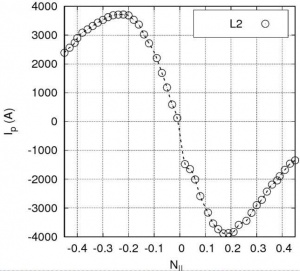TJ-II:Validation of ECCD predictions in TJ-II ECRH plasmas
Experimental campaign
2018 Spring
Proposal title
Validation of ECCD predictions in TJ-II ECRH plasmas
Name and affiliation of proponents
José M García Regaña1, Á. Cappa1, A. Gozález-Jeréz2, A. López-Fraguas1, N. B. Marushchenko, ... 3 and TJ-II team1.
Description of the activity, including motivation/objectives and experience of the proponent (typically one-two pages)
The current driven by means of EC waves, so-called Electron Cyclotron Current Drive (ECCD), has been proposed as a tool for non-inductive current induction in tokamaks, as well as a mean of current control and tailoring of the rotational transform in stellarators. In particular, it can modify through its impact on the map of Alfvén eigenmode (AE) and with it the fast ion dynamics. In view of future studies of AE-induced fast ion losses in TJ-II the present proposal focuses on the validation of the ECCD predictions comparing these with the experimental values.
Description of required resources
The main experiment conditioning requirements are:
- ECH is the only heating system that will be employed. The characterization of the current driven will be done according the following strategy:
- Characterization of the current driven using only the transmission line QTL1, injecting on-axis and with . Considering 2 discharges per value of 10 discharges.
- Characterization of the current driven using only the transmission line QTL2, injecting on-axis and with . Considering 2 discharges per value of 10 discharges.
- Characterization of the current driven using only the transmission line QTL1, injecting on-axis and with , simultaneously to the employment of QTL2 with on-axis for auxiliary heating the background plasma. Considering 2 discharges per value of 10 discharges.
- Characterization of the current driven using only the transmission line QTL2, injecting on-axis and with , simultaneously to the employment of QTL1 with on-axis for auxiliary heating the background plasma. Considering 2 discharges per value of 10 discharges.
- Finally, for large the partial loss of X-mode polarization and the presence of spurious O-mode is expected at the resonance layer. Then, the current induction and power absorption may be sub-obtimal, and a scan on the ellipticity of the beam polarization at its launching position is foreseen in order to correct this effect. 10 discharges needed.
- The discharges should be sufficiently long and the electron collisionality sufficiently high to capture the exponential growth of the induced toroidal plasma current and estimate the asymptotic value of it and the L/R time. Thus, time pulses of 250 ms. are initially planned and densities as high as ECH conditions allow.
- The magnetic configuration run during the experiments will be the standard.
- Good stationarity of plasma parameters is needed for the analysis.
The required signals to perform the analysis are:
- The time evolution of the toroidal plasma current.
- The time evolution of the line-averaged density Failed to parse (syntax error): {\displaystyle \left<n_e(t)\right>} with interferometry.
- The radial profiles of electron density and temperature at one time instant using Thomson Scattering (TS).
- The time evolution of the electron temperature profile with Electron Cyclotron Emission (ECE), when available, calibrated with TS.
- The time evolution of the main ion temperature profile with the CNPA are two positions representative of the inner and mid core.
Preferred dates and degree of flexibility
Preferred dates: due to the availability on-site of the proponents the experimental days should fall out of the calender week 14.









